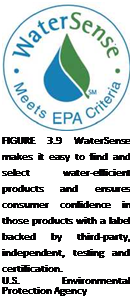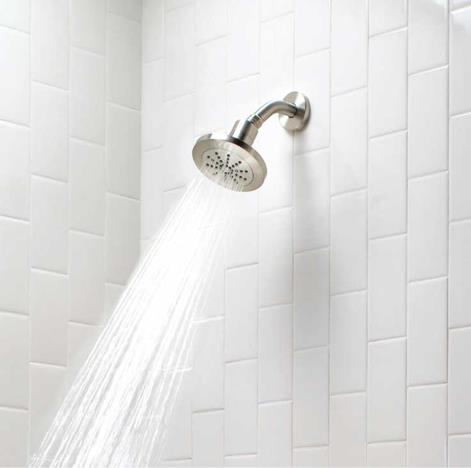WaterSense® is a public-private partnership program between the Environmental Protection Agency and manufacturers to provide water-efficient products. WaterSense products have been independently tested and certified. As a result of meeting the WaterSense standards, the products can bear the WaterSense logo (see Figure 3.9) in all packaging, marketing, and promotion.
Generally, products that meet the WaterSense standards are 20 percent more efficient than comparable products on the market. In addition, the products must perform their intended function without sacrificing performance, especially to conserve water. In addition, through an agreement between the Environmental Protection Agency and Environment Canada, WaterSense products will be available in Canada.

 |
 |
Choosing WaterSense products for a bathroom offers the designer an excellent opportunity to maximize the sustainable use of water in the bathroom. In fact, the majority of WaterSense products currently available are residential bathroom fixtures! The designer can choose WaterSense toilets, bathroom lavatory faucets and aerators, and showerheads. WaterSense products offer an opportunity to increase water efficiency yet still give the designer many options in creating a unique, and perhaps luxury, space.
WaterSense Toilets
The current standard for a toilet is 1.6 gallons (6 liters) per flush (gpf or Ipf). The WaterSense toilet specification is 1.28 gpf (4.8 lpf). Some toilets on the market offer even more efficient water use, such as 1.0 gpf (3.8 lpf).
Manufacturers have achieved the efficient use of water for toilet flushing through the use of different technologies. This includes improving the existing flushing system or using air pressure to power the flush. With a dual-flush system, more water is used when flushing solid waste than liquid waste, but the average water use meets the WaterSense standard. Some toilets may use a pump to assist the flush, requiring an electrical connection for installation.
WaterSense toilets must also meet the minimum MaP threshold for flushing of solid waste: 350 grams of solid waste (including toilet paper) in a single flush. The MaP (Maximum Performance Testing) program creates a standard of effective performance that prevents double flushing, and thus inefficient use of water. MaP is a voluntary testing program recognized in both the United States and Canada.



